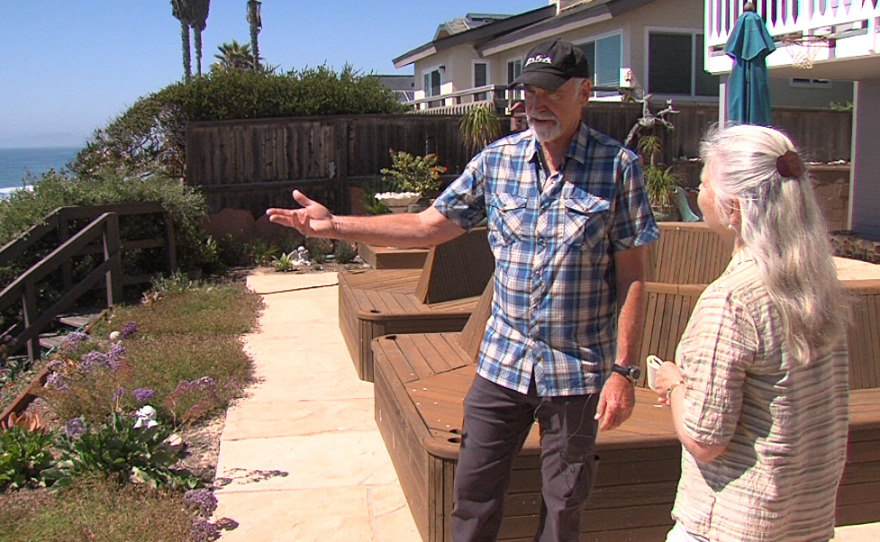Two Encinitas beachfront property owners bring a case before the California Supreme Court today. The effort to replace the damaged seawall has raised questions about how the state will ultimately deal with sea level rise and coastal erosion. North County reporter Allison St. John has the story. They granted homeowners a permit to rebuild this damaged seawall at the bus leave their homes. An attorney representing the homeowner says there was a catch. The permit was only good for 20 years. It does not give the commission the authority to impose an arbitrary time limit on the permit and you that is what they did. The trial court declared that to be what is called a regulatory taking of the property. The climate scientist with the Scripps institution of oceanography contributed to a recent rip that suggests sea level rise may happen faster than predicted if Antarctic ice shelf smelts. I think we will have to deal with this model the property by property basis but as a unified approach what are we going to do. They come up with a plan that is viable or decades in advance. This the arguments in the seawall case. Joining me for more is a Scripps scientist. Thank you. Allison mentioned a report on faster sea level rise. One of the big takeaways is that it could rise up to 10 feet in about 70 years. Is is a worst-case scenario? It's important to emphasize that it's a physically possible but probably on the narrow edge of likelihood scenario. There is many other scenarios that lie at rates of sea level rise in the amounts by the end of the century that are much less than that the nature of this problem is that there is a great deal of uncertainty not only because the science is still maturing but because human activities loading the atmosphere with greenhouse gases is essentially somewhat unpredictable. Just to give us an idea what does a 10 foot rise look like for us here in San Diego. 10 feet is really remarkable number and that is the very high and but to kind of put this into historical context over the last century we have seen sea level rise at about seven inches along the California coast of Mendocino. Even a three foot rise which may be a community consensus number four 2100 or at least it was probably a year or so ago is really pretty enormous. 10 feet is really quite catastrophic and many ways. As he mentioned his projections have been revised upward recently. What is driving these new figures. In a modeling sense to look forward the amounts of ice loss from the big sheets in Greenland and Antarctica and in particular West Antarctica have the potential to undergo a massive loss of ice essentially shutting ice into the ocean at a much more rapid rate than was not previously. Is the fact that the ice is melting faster than predicted have to do with what we don't understand about this continent and the amount of ice or because the atmosphere is warming up faster than we expected. We think it is some of. There have been records of sea level rise going back a century is -- or so as best as the community can make out a lot of the sea rise and the earlier part of the 20th century can be a tribute mostly to the fact that the oceans were warming and the oceans were thermally expanded. However the over the last decades it looks like the contribution from the ice sheet in Greenland and Antarctica has increased that is almost unassailable because we have remote sensed estimates from satellite measurements of various kinds. The amount of ice loss as the atmosphere continues to warm which is well observed and well -- will increase and is likely to increase at a more rapid rate as we move on into the decades of -- of the 21st century. Does this case highlight the fact that California should be coming up with a coastal strategy to deal with rising sea level whether it is the worst case scenario or something less than that? I think the coastal commission actually has a strategy it is just that it is encumbered by a lot of prickling is in the way that they make decisions. And that tension will probably continue to be debated. Thank you
The California Supreme Court will hear arguments Thursday in a case that confronts the question of how California will ultimately deal with rising sea levels: Will there be extensive “armoring” of the coast line, or will the state adopt a policy of “managed retreat?”
The case involves two Encinitas property owners whose homes stand side-by-side at the top of towering sandstone cliffs overlooking the Pacific Ocean.
From his patio, Tom Frick surveys the surfers skimming the waves below and the pelicans flying in formation above.
“I’ve lived here about 25 years, I built this house,” he said. “I don’t want my house to slip in the ocean.”
Frick said the beach has narrowed over the decades, and now the ocean waves beat right up against the cliffs at the foot of his property.
“It’s beautiful here,” he said. “It’s just that it’s real challenging trying to deal with the property and the ocean and the seawall.”
Frick and his neighbors, the Lynches, replaced the original seawall at the foot of the cliffs, after it was damaged in winter storms in 2010.
“It’s a good million-dollar wall between my neighbors and myself," he said. “It’s supposed to last 70 years.”
But the California Coastal Commission granted a 20-year permit for the seawall.
In a legal brief explaining the time limit, Coastal Commission attorneys wrote, “The conditions allow the commission to revisit the need for the seawall or to require further mitigation for its impact, based on, but not exceeding, the remaining anticipated lifespan of the plaintiff’s existing home.“
Frick’s attorney, Jon Corn, said this amounts to a legal “taking" of Frick’s property. He said it effectively reduces the value of the homes if they were to go on the market, because of the uncertainty of what the Coastal Commission might do in 20 years.
Corn said the California Coastal Act says the commission shall allow seawalls in places where structures are in danger of being destroyed due to erosion.
“The Coastal Act does not give the Coastal Commission the authority to impose an arbitrary time limit on the permit,” Corn said, “but yet that’s what they did.”
The legal battle
San Diego Superior Court Judge Earl Maas agreed in 2013, declaring the time limit to be ”a regulatory taking of property.”
But in 2014 a state appeals court reversed that decision, saying that when the homeowners accepted the permit, they accepted the conditions.
The Pacific Legal Foundation, which litigates to protect private property rights, has taken on the case, and many interested parties have joined it. The Building Industry Association and the California Association of Realtors have filed briefs in support of the Fricks and the Lynches, while groups like the American Planning Association and the Surfrider Foundation have filed in support of the Coastal Commission.
The California Coastal Commission did not make itself available to comment on the ongoing litigation. But the case is particularly relevant in view of a new report by the California Ocean Protection Council and the California Natural Resources Agency, in collaboration with the Governor’s Office of Planning and Research and the California Energy Commission. It concludes new scientific evidence highlights the potential for extreme sea level rise by the end of the century.
California’s rising seas
Dan Cayan, a climate scientist with the Scripps Institution of Oceanography, contributed to the report. He said the sea level has risen a little more than six inches over the past half century, and under one plausible scenario, it could rise up to three feet in the next century.
But he said the report contains one extreme scenario, where melting ice sheets in Antarctica could lead to much higher numbers.
“We’re now looking at levels that could exceed eight feet, perhaps as much as 10,” he said.

Cayan said building seawalls may be a good short-term strategy.
“Of course, that’s the way I would feel if I had coastal property,” he said, “but if I’m looking at it holistically like the Coastal Commission, they have to think about the whole coast.”
Cayan said for every homeowner that builds a seawall, there are several others who do not, and they are likely to suffer the unintended consequences of wave action penetrating their property faster because of the armoring next door.
“In the long term,” Cayan said, “if we get amounts of sea level rise that exceeds three feet, it may be it’s just so much that it will overwhelm the viable structures that we build today.”
Not willing to gamble
Cayan said agencies like the Coastal Commission will have to judge how to craft policies to match the rising seas, and that will only become clear over time.
“At some point we are going to have to deal with this, not on a property-by-property basis, but as kind of a unified approach to a coastal community,” Cayan said. “What are we doing to do to protect infrastructure and inhabitants and come up with a plan that’s viable, for decades in advance?”
Frick is not willing to gamble on what the policies will be in 20 years.
“This is a very important case,“ Frick said. “This affects everybody up and down the coast of California and there’s a lot of coast in California. It’s a big deal, that’s why the state Supreme Court is taking this on.”
Frick is not sure what he would do if the State Supreme Court rules against him but Corn, his attorney, said it could go all the way to the US Supreme Court.
“I would say the rights at stake are important enough that there would be a desire to bring it to the United States Supreme Court, though it’s hard to say at this point whether that would happen or not,” Corn said.
The California Supreme Court hears arguments Thursday and is expected to issue its ruling within the next 90 days.






